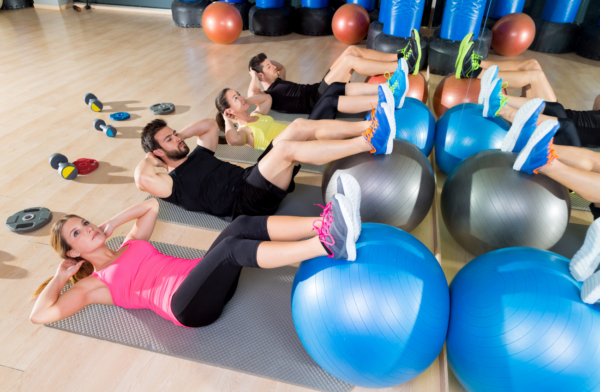Section 1: Fundamentals of Exercise Science
Module 1: The Group Fitness Industry
Learn about the state of health and fitness today. This understanding will provide insight into why your pursuit of a career in fitness with the Athletics and Fitness Association of America (AFAA) will help you become so influential in improving the lives of others. You will also explore AFAA’s history with group fitness, and our foundation of evidence-based practice.
Module 2: Foundations of Exercise Science
Helping others reach their fitness goals requires the knowledge to analyze the basics of human movement thoroughly. Biomechanics and the interactions of the muscle action spectrum provide you with the language of exercise science and a foundational understanding of the human body.
Module 3: The Human Movement System
Armed with the basics of biomechanics, you can now begin to learn the functions of the Human Movement System (also referred to as the kinetic chain). The kinetic chain is comprised of three different, yet intimately interwoven, systems that allow our bodies to move. The knowledge related to these systems and their interactions will help you guide the individuals you work with to move safely and effectively.
Module 4: Integrated Fitness
Integrated fitness is the foundation for the successful development of any fitness program, combining multiple types of exercise to help participants achieve their goals. Through the application of the various components of integrated fitness, you can design safer, more effective fitness classes.
Section 2: Class Design and Planning
Module 5: Teaching Basics
Using the principles of integrated fitness, you may now begin to piece together the five components of a workout for a unified class flow. Through an in-depth exploration of each of the five components (intro, movement prep, the body of the workout, transition, and outro), you can identify the various considerations for the most popular formats, including training intensities and appropriate exercise selection.
Module 6: Teaching: Multi-training and Exercise Technique
One precious resource for an aspiring Group Fitness Instructor is a vast inventory of exercises that might be useful across multiple formats. Additionally, instructors should be familiar with the appropriate technique for each exercise they offer, as well as be prepared to offer modifications to accommodate participants’ needs.
Module 7: Class Planning and Preparation
After understanding integrated fitness, the components of a workout, and appropriate exercises across popular formats, instructors can apply their knowledge in the classroom. Thoughtful class planning allows instructors the opportunity to refine the intended outcomes of their classes by selecting elements such as music, equipment, and movement options to best suit their intended goals.
Section 3: Class Instruction and Presentation
Module 8: Adapting to Class Dynamics
Instructors must do more than simply plan for their classes. They must also be prepared to encounter unexpected variables the day-of. Knowing how to respond to numerous situations, from surprise visitors to medical emergencies, will help you in your efforts to provide a safe and inclusive experience for everyone. Diligent classroom set-up can help avert complications before they begin.
Module 9: Communication and Learning
While in-depth knowledge of proper exercise execution and workout design is essential for all Group Fitness Instructors, the test of a genuinely successful instructor lies in connecting with participants through their preferred learning styles and active cueing. Generally speaking, the best way to connect with participants is by providing participant-centered instruction that acknowledges individual needs while still serving the group.
Module 10: Inclusive Instruction for Special Populations
Participant-centered instruction requires an understanding of the various levels of conditioning that may affect an individual’s performance in a group workout. By understanding the various considerations and modifications available, you can provide support for every participant without singling them out or sacrificing the quality of a workout.
Module 11: Class Engagement and Motivation
Effective instructors do more than offer safe movement experiences. They connect with their participants, which engages and motivates them to continue returning time and time again. By motivating every participant in a way that empowers them to meet their goals, you’ll build value for your participants.
Section 4: Other Notable Topics
Module 12: Professional and Legal Responsibilities
As with any career, there are legal, ethical, and professional expectations for certified Group Fitness Instructors. Included in these expectations is the need for continued educational and experiential development, as well as methods for self-care to help you sustain and thrive.
Module 13: Nutrition
Achieving optimal health and fitness goes beyond human movement, it also encompasses nutrition. Nutrition is an evolving and quickly changing science. As new research is conducted, new information provides fresh insights that may influence the work you do as a Group Fitness Instructor. This module will provide you the basic nutritional information you will need for discussions with participants, as well as to benefit your health and well-being.
Final Exam
After the completion of the course, you will take a proctored final exam. This exam can be taken online, through a live-remote proctor, or in-person at one of our many testing facilities. The test consists of 120 multiple-choice questions. You will have 120 minutes to complete the exam. To pass, you need a score of 70% or higher. To register for your exam, please see our Exam Information page.
You have six months from your date of purchase to pass your exam.
BONUS! Fundamentals of Virtual Coaching
How does training from the comfort of your own home sound? Select AFAA-GFI programs now come with exclusive bonus content provided by our sister company, NASM. Learn how to train and manage clients virtually. Learn everything from setting up equipment, creating digital programs, taking payments and more! Course includes 5 in-depth lessons, a 10-part video series, and more.



